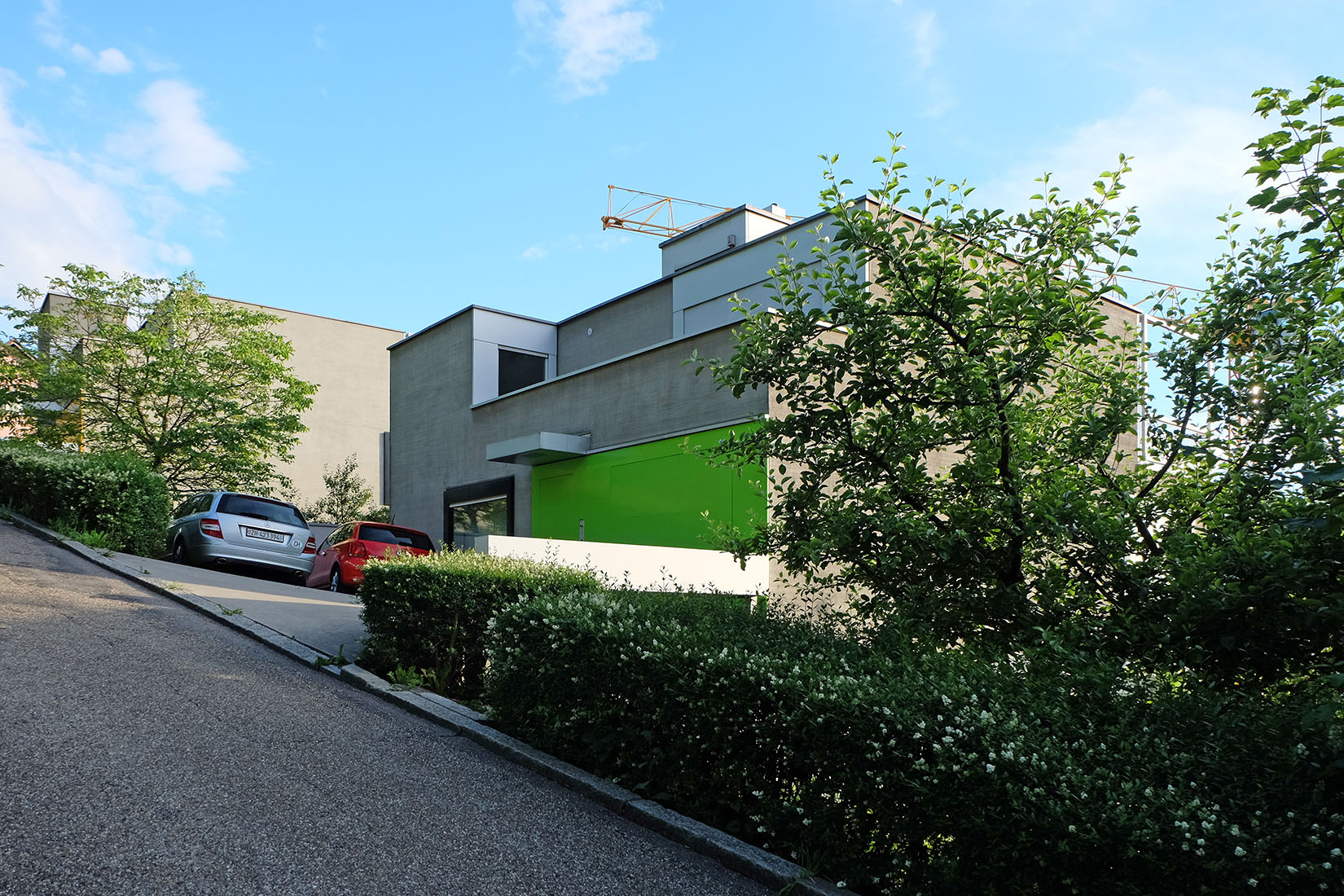 |
 |
 |
 |

Two Houses
Krattenturmstrasse 22 / 24, Zürich
1995 - 1998
The structure of the two buildings consists of concrete ceilings, masonry, and concrete walls, where they are facing the ground. The interiors are largely rough and untreated. For example the walls and the ceilings are plastered with gypsum, but they are not painted. Sealed anhydrite is used as floorings. Large windows with distinctive black frames characterize the facade. Tightly aligned towards the west, facing the city of Zurich. On the other facades, the same windows appears sporadic. As a facade plaster, a lime cement plaster is used, the broom structure emphasizes the rough character and expresses the textile character of the construction, based on a mineral exterior insulation. The façade appears in dark and earthy shades, contrasting with the doors and gates painted in bright colors. The attic is set back and forms generous terraces, which are connected to the living rooms by large aluminium windows. The two houses are located in gardens planted with fruit trees and walnut trees, while the steepest part is covered with bramble bushes and hazelnut bushes, preserving the somewhat braided character of the site.
Ende der 1990er Jahre konnten die Architekten Gigon Guyer zwei Wohnhäuser am Zürichberg bauen. Der Auftrag resultierte aus einem gewonnen Studienauftrag und führte zur Bebauung eines steilen Pflanzgartens mit kompakten Baukörpern nach dem Vorbild der benachbarten Ein- und Mehrfamilienhäuser. Beide Bauten werden von der höher gelegenen Strasse erschlossen, wobei eine markante Zufahrtsrampe sich über die gesamte Hausbreite erstreckt und den Vor- sowie Parkplatz bildet. Die beiden Bauten sind als allgemeine Wohnbauten konzipiert, das heisst sie sind nicht spezifisch auf die Bedürfnisse der aktuellen Eigentümer ausgelegt, sondern sollen einfach für andere Benutzer oder für andere Lebensumstände anpassbar sein. In der ausgeführten Raumdisposition ist eine unabhängige Einliegerwohnung vorhanden, die Unterteilung in zwei gleich grosse Maisonettewohnungen ist vorgesehen. Zudem wurden Vorbereitungen für weitere Unterteilungen und auch den Einbau eines Aufzugs getroffen. Grosszügige Schiebetüren aus Holzwerkstoffen erlauben Variationen der räumlichen Unterteilungen und Zusammenhänge.
Das Tragwerk der beiden Bauten besteht aus Ortbetondecken, Mauerwerk, und Ortbetonwänden zum Erdreich. Die Innenräume sind weitgehend als Rohbauten behandelt. So sind die Wände und die Decke zwar mit Weissputz behandelt, aber nicht gestrichen. Als Bodenbelag kommen versiegelte Anhydritböden zum Einsatz. Grosse Fenster mit markanten schwarzen Rahmen prägen den Ausdruck der Fassade. Dicht aneinander gereiht nach Westen, mit Blick Richtung Stadt Zürich. An den anderen Fassaden treten die selben Fenster in vereinzelter Form auf. Als Fassadenputz kommt ein Kalk-Zementputz zur Anwendung, die Besenstrich Struktur betont das rohbaumässige und bringt den textilen Charakter der Konstruktion auf Basis einer mineralischen Aussenwärmedämmung zum Ausdruck. Die Fassade erscheint in dunklen und erdigen Farbtönen und kontrastiert mit den Türen und Toren, welche in leuchtenden Farben gestrichen wurden.Das Dachgeschoss ist zurückversetzt, und bildet dadurch grosszügige Terrassen, welche mit grossflächigen Fensterfronten in Verbindung zu den Wohnräumen stehen. Die beiden Häuser stehen in Gärten, welche mit Obst- und Nussbäumen bepflanzt wurden, im steilsten Bereich befinden sich Brombeer- und Haselnussstauden, so dass der etwas verwilderte Charakter des Ortes beibehalten wird.
